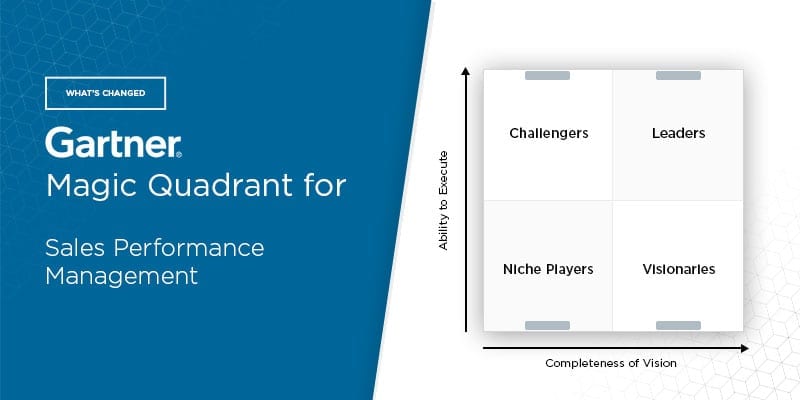What’s Changed: 2020 Gartner Magic Quadrant for Sales Performance Management


The editors at Solutions Review highlight what’s changed in the 2020 iteration of the Gartner Magic Quadrant for Sales Performance Management and provide an analysis of the new report.
Analyst house Gartner, Inc. recently released the 2020 version of its Magic Quadrant for Sales Performance Management. Gartner defines Sales Performance Management (SPM) solutions as a suite of operational and analytical functions that automate and unite back-office operational sales processes, implemented to improve operational efficiency and effectiveness. This year’s report indicates that the market grew 14 percent, to $1.099 billion in 2019. Application leaders supporting sales technology should focus on operational excellence and use advanced analytics with machine learning to increase and maximize operational and planning effectiveness.
Recent SPM trends and innovations include developing capabilities around natural language processing (NLP) for more data-driven insights. There has also been increased focus on compensation plan optimization and next-best-action recommendations provided to sales reps. Machine learning (ML) and NLP have also been increasingly used to address dispute resolution, reduce administrative burden, and improve analysis on compensation data and results.
What’s Changed: 2020 Gartner Magic Quadrant for Sales Performance Management
In this Magic Quadrant, Gartner evaluates the strengths and weaknesses of 10 providers that it considers most significant in the marketplace and provides readers with a graph (the Magic Quadrant) plotting the vendors based on their ability to execute and their completeness of vision. The graph is divided into four quadrants: niche players, challengers, visionaries, ad leaders. At Solutions Review, we’ve read the report, available here, and pulled out the key takeaways.
Gartner adjusts its evaluation and inclusion criteria for Magic Quadrants as markets evolve. As a result, Varicent has been added to this year’s report after IBM divested its SPM business. Iconixx has been dropped, and SAP (CallidusCloud) is now referred to as SAP.
Varicent (IBM) tops this year’s Leaders quadrant, having purchased all of IBM’s SPM solution assets as of 31 December 2019. Varicent offers some of the most scalable technology out of all the vendors in this year’s Magic Quadrant, particularly in fast processing speeds for large and complex deployments. Varicent has also received several positive references for its ease of deployment and responsive vendor resources. Xactly has achieved some vertical momentum in this year’s report through continued innovation and execution. This vendor remains focused on customer success and targeted marketing messages, exceeding the overall average of other vendors in customer satisfaction.
SAP maintains its position through a strong product strategy and a broad range of offerings related to SPM. It continues to experience healthy year-over-year growth and maintains the largest payee base of all vendors in this year’s report. Customers have also noted the flexibility of its ICM, saying that it was easy to administer. Anaplan is once again positioned in the Leaders quadrant as it continues to enhance its core incentive compensation functionality. Its platform provides a hub that connects other compensation plans to financial plans within an organization, and its product offers optimization for quota, territories, and incentives.
Oracle has gained some upwards momentum with strong investments in advanced analytics. It now offers RESTful services for incentive compensation objects and Visual Builder. Oracle also provides a strong sales strategy with clear persona-based value messaging. Customers also gave Oracle high scores for quality of customer support, noting a very responsive customer support experience. Optymyze continues to be recognized as a Leader; its SPM applications are easy for business users to administer, and customers cite its flexibility, simple dashboard building, and impressive reporting.
NICE sits at the top of this year’s Challengers quadrant with proven capabilities for handling large transaction volumes with its calculation engine. By incorporating intelligent recalculation, horizontal scaling, and in-memory processing, NICE’s platform can handle the compensation complexity of large enterprises. Beqom continues to improve functionality for administrators and maintains a focus on global enterprises and customer success as its main value proposition. Beqom now also offers industry templates and a plug-and-play solution called Easypacks for financial services to streamline deployment.
Incentives Solutions is the sole vendor in this year’s Visionaries quadrant, improving its Ability to Execute from last year. It has started to expand sales beyond Europe to increase its global presence and has seen success in verticals such as high tech, media, financial services, and the public sector. This vendor is in the top third of all vendors evaluated in this Magic Quadrant to retain customers, and its professional services team has been cited as particularly competent.
Last but not least, Performio stands alone in the Niche Players quadrant. It continues to expand its North American market, winning competitive software package replacements across different verticals. Performio is one of the few vendors in this Magic Quadrant to offer managed services to its customers and utilizes its own professional services team for deployments. It has made many improvements to its UI, and end-user interfaces have been cited as easy to use. They are also easy to configure without requiring IT involvement.





















